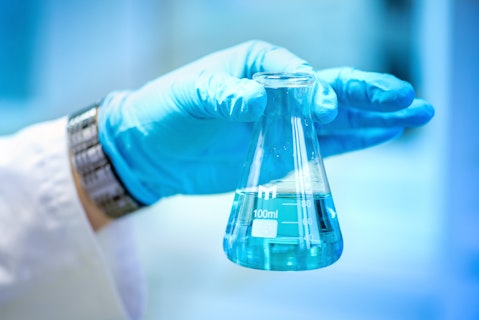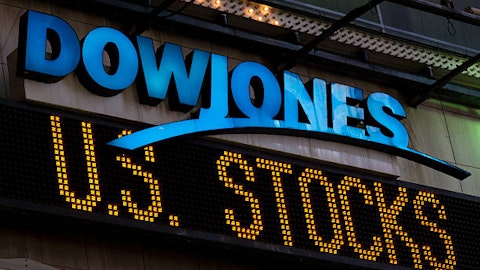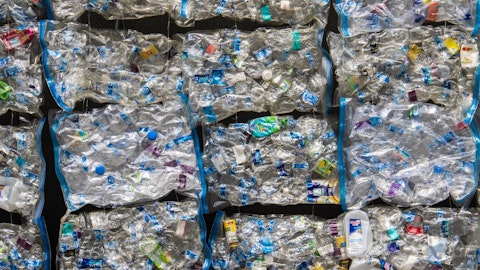Dow Inc. (NYSE:DOW) Q4 2022 Earnings Call Transcript January 26, 2023
Operator: 2022 earnings conference call. As a reminder, this conference is being recorded. I will now turn it over to Dow Investor Relations Vice President, Pankaj Gupta. Mr. Gupta, you may begin.
Pankaj Gupta: Good morning. Thank you for joining Dow’s fourth quarter earnings call. This call is available via webcast, and we have prepared slides to supplement our comments today. They are posted on the Investor Relations section of Dow’s website and through the link to our webcast. I’m Pankaj Gupta, Dow Investor Relations Vice President. And joining me today on the call are Jim Fitterling, Dow’s Chairman and Chief Executive Officer; and Howard Ungerleider, President and Chief Financial Officer. Please read the forward-looking statement disclaimer contained in the earnings news release and slides. During our call, we will make forward-looking statements regarding our expectations or predictions about the future. Because these statements are based on current assumptions and factors that involve risks and uncertainties, our actual performance and results may differ materially from our forward-looking statements.
Dow’s Forms 10-Q and 10-K include detailed discussions of principal risks and uncertainties, which may cause such differences. Unless otherwise specified, all financials where applicable exclude significant items. We will also refer to non-GAAP measures. A reconciliation of the most directly comparable GAAP financial measure and other associated disclosures is contained in the Dow earnings release, in the slides that supplement our comments today as well as on the Dow website. On Slide 2, you will see the agenda for our call. Jim will begin by reviewing our fourth quarter results and operating segment performance. Howard will then share our outlook and modeling guidance. And to close, Jim will then outline our competitive position for long-term value creation.
Following that, we will take your questions. Now let me turn the call over to Jim.
Jim Fitterling: Thank you, Pankaj. Beginning on Slide 3. In the fourth quarter, Team Dow continued to take proactive actions to navigate slower GDP growth, challenging energy markets and customer destocking. We proactively lowered our operating rates to effectively manage working capital, implemented operational mitigation plans and cost saving measures and prioritized higher-value products where demand remained resilient, including in functional polymers and performance silicones as well as in mobility, renewable energy and pharma end markets. These actions, combined with our continued focus on cash enabled us to deliver cash flow from operations of $2.1 billion in the quarter. Cash flow conversion was 166%, and we returned $620 million to shareholders.
Dow’s cash generation reflects our continued focus on operational and financial discipline, which was important as we navigated an extremely dynamic year in 2022, as you see on Slide 4. In the first half of the year, we capitalized on strong demand across our diverse global portfolio while leveraging our derivative and feedstock flexibility and low-cost positions to mitigate higher raw material and energy costs. In the second half of the year, economic conditions deteriorated driven by record inflation, rising interest rates, ongoing pandemic lockdowns in China and continued geopolitical tensions. In the face of these evolving market dynamics, Dow was resilient, generating cash flow from operations of $7.5 billion for the full year. While executing our disciplined and balanced approach to capital allocation.
We delivered returns on invested capital of 15%, above our 13% across the economic cycle target, as we prioritized higher return, lower risk and faster payback investments. We achieved credit rating and outlook upgrades as a result of our strengthened balance sheet, and we have no substantive debt maturities due until 2027. And we returned a total of $4.3 billion to shareholders, including $2.3 billion in share repurchases and $2 billion in dividends. At the same time, we continue to advance our Decarbonize and Grow strategy and accelerate circularity to create long-term shareholder value as we meet growing customer demand for more sustainable solutions. I’m proud of how Team Dow continues to deliver for our customers, drive shareholder value and support our communities as we progress toward our 2050 carbon neutrality target, and you can see a number of those highlights depicted on this slide.
Now turning to our operating segment performance on Slide 5. In the Packaging & Specialty Plastics segment, net sales were $6.1 billion, down 16% year-over-year as price gains across all regions and functional polymers were more than offset by lower polyethylene and olefin prices. Volume declines were driven primarily by lower olefins and packaging demand in Europe, which was partly offset by a resilient global demand for functional polymers. Sequentially, net sales were down 17% driven by lower hydrocarbon sales and polyethylene prices. Operating EBIT for the segment was $655 million compared to $1.4 billion in the year ago period, primarily due to lower integrated polyethylene margins. Sequentially, operating EBIT was down $130 million as lower raw material and energy costs were more than offset by lower polyethylene prices and operating rates.
Moving to the Industrial Intermediates & Infrastructure segment. Net sales were $3.7 billion, down 20% from the year ago period. Volumes declined primarily due to lower demand in Europe for industrial, consumer durables and building and construction applications. Sequentially, net sales were down 10% as seasonal demand increases for deicing fluid were more than offset by declines in building and construction, consumer durables and industrial applications. Operating EBIT for the segment was $164 million compared to $595 million in the year-ago period, driven by lower demand and increasing energy costs, particularly in Europe. Sequentially, operating EBIT margins expanded by 40 basis points as lower energy costs versus the prior quarter were partly offset by lower volumes.
And in the Performance Materials & Coatings segment, we reported net sales of $2.1 billion, down 20% year-over-year as local price gains for performance silicones and architectural coatings were more than offset by lower prices for siloxanes and acrylic monomers. Volume was down as resilient demand in mobility was more than offset by declines primarily in building and construction end markets. Sequentially, net sales were down 22% due to seasonally lower demand for coatings, industrial and building and construction applications as well as local price declines for siloxanes and acrylic monomers. Operating EBIT for the segment was a loss of $130 million compared to earnings of $295 million in the year-ago period due to local price declines primarily in siloxane and lower operating rates in the quarter.
Sequentially, operating EBIT declined $432 million, driven by lower prices, demand and operating rates. I’ll now turn it over to Howard to review our outlook and actions on Slide 6.
Howard Ungerleider: Thank you, Jim, and good morning, everyone. We expect the market dynamics we experienced in late 2022 to continue into early ’23. While the pace of inflation has moderated, overall cost levels remain elevated, which has continued to trigger tighter monetary policy in most parts of the world and is weighing on both business investment and consumer sentiment. The majority of economic forecasts are calling for slower GDP growth globally relative to 2022, although dynamics differ by region, with most regions except Europe still forecasting positive year-on-year growth. In the U.S., we see signs of moderating demand and the continuation of year-end destocking trends early in the quarter. Building and construction end markets have been particularly impacted by inflation and rising interest rates with housing starts declining by more than 20% year-over-year in December.
Manufacturing PMI contracted for the third consecutive month of 48, while light vehicle sales in the U.S. were down for the full year by 8 percentage points. Easing inflation is leading to improving consumer confidence, albeit from depressed levels in late 2022, while consumer spending remains resilient. In Europe, we expect demand to remain constrained despite recent improvements in regional energy prices. While the move to five-year highs in gas storage is a positive sign, changing weather forecasts are leading to volatility in the futures markets. High inflation and geopolitical tensions continue to weigh on consumer spending and industrial production. December manufacturing PMI has been contracting since July, and construction PMI reached its lowest level since May.
In China, while we’re very encouraged by recent ships in COVID policy to ease restrictions and open up orders, we expect these actions to take some time to improve economic activity. This is an area we’re closely monitoring as it has the potential to provide a source of significant demand recovery following the Lunar New Year. And in Latin America, overall economic growth is expected to slow, driven by political tensions, high inflation and restrictive monetary policy. Given this dynamic backdrop, we will continue to take a region by region, business-by-business approach to managing our operations and adapting our businesses to the evolving market realities. Turning to Slide 7. As we highlighted at our last earnings call, we are proactively responding to the current economic environment with a playbook of targeted actions to deliver $1 billion in cost savings.
This begins with maintaining a low cost to serve operating model by implementing actions to optimize our labor and service costs, including a global workforce reduction of approximately 2,000 roles. We will continue to increase productivity with end-to-end process improvements now that our digital foundation is in place, and we will also shut down select assets while further evaluating additional actions across our global asset base, particularly in Europe to ensure long-term competitiveness while also enhancing our cost efficiency. These structural actions are expected to deliver a total of $500 million in EBITDA savings this year. Additionally, we will deliver another $500 million of savings through actions to maximize cash flow while reducing our operational expenses.
This includes decreasing turnaround spend, purchased raw materials, logistics and utilities costs. Importantly, we will do this while maintaining safe and reliable operations, which, as always, remains our top priority. These proactive actions will optimize our cost structure in response to the near-term macroeconomic uncertainty while maintaining our long-term value-creation focus. Turning to our outlook for the first quarter on Slide 8. In the Packaging & Specialty Plastics segment, improving logistics and lower operating rates led to the fifth consecutive month of inventory declines for U.S. polyethylene in December. Reduced global operating rates are continuing to drive feedstock and input costs down with ongoing destocking through the value chain impacting functional polymer strength and demand in Europe.
While lower turnaround costs will be a sequential tailwind, we expect lower demand levels in Asia to impact equity earnings and lower nonrecurring licensing activity from the prior quarter will impact earnings. In total, we expect a $75 million headwind for the segment sequentially. And the Industrial Intermediates & Infrastructure segment, demand remains stable for energy markets, and we’re monitoring demand for deicing fluids with a warmer than average winter. However, inflationary pressures in contracting PMIs continue to impact industrial demand, and we expect lower seasonal volumes in building construction end markets. We also anticipate an approximately $25 million headwind due to a third-party outage, which is causing a supply disruption on the U.S. Gulf Coast from winter storm Elliott.
And in the Performance Materials & Coatings segment, we expect demand recovery for performance silicones following year-end customer destocking as well as improved supply availability and lower costs. However, we also anticipate lower siloxane pricing in the quarter as we continue to see pressure from increased industry supply. We expect higher planned maintenance turnaround costs in this segment at our Deer Park acrylic monomer site in performance monitors. All in, we anticipate a $25 million tailwind for the segment. In total, we expect the first quarter to be in line with the fourth quarter performance with the $75 million in discrete headwinds I mentioned. Turning to the full year. We’re continuing to provide our best estimates of several income statement and cash flow drivers.
I will highlight a few notable year-over-year inputs. We expect lower equity earnings in the year down approximately $300 million to $400 million. Total turnaround spending is anticipated to be down by $300 million as we implement our playbook of cost savings actions while maintaining safe and reliable operations. We expect share count to remain relatively flat as we plan to continue covering dilution. And finally, we anticipate increasing our capital expenditures to $2.2 billion, well within our D&A of $2.8 billion as we continue to advance our higher return, faster payback projects and continue to execute on our decarbonized and growth strategy. Overall, the macroeconomic backdrop remains dynamic in 2023, we see the potential for additional upside from higher oil to gas spreads, reopening in China following the Lunar New Year and easing inflation and supply chain constraints.
We also continue to pay close attention to a range of indicators, including pressure from higher interest rates on building and construction, PMI levels, global energy markets and geopolitical dynamics. Dow remains well positioned based on our global footprint, feedstock flexibility and the sustainable solutions we provide for our customers. We will continue to leverage these competitive advantages to deliver long-term value for our shareholders. With that, I’ll turn it back to Jim.

bogdanhoda/Shutterstock.com
Jim Fitterling: Thank you, Howard. Moving to Slide 10. While the near-term environment remains challenging, we continue to see attractive secular trends across our market verticals of packaging, infrastructure, consumer and mobility. With resilient cash flow generation and a strong credit profile, we are well positioned to continue advancing our Decarbonize and Grow strategy to capitalize on these opportunities. We Delivered on our growth investment commitments outlined in early 2022. These investments are expected to collectively generate $2 billion in run rate EBITDA by the middle of this decade. In Packaging & Specialty Plastics, we mechanically completed and began final commissioning of our FCDh unit in Louisiana in the fourth quarter.
This breakthrough propylene technology features up to 25% lower capital outlay while reducing energy usage and greenhouse gas emissions by up to 20% versus conventional FCDh units. In Industrial Intermediates & Infrastructure, our latest alkoxylates capacity investment in the United States was completed in the third quarter of 2022, and our next in Europe will be completed in the first quarter of this year. These projects will further serve high-value markets in home care and pharma and are just a start. Our next wave of alkoxylates capacity investments remain on track. In fact, Dow has already successfully begun locking in supply contracts with several consumer and pharmaceutical customers to support the next wave of growth. And in Performance Materials & Coatings, we completed 16 downstream silicone debottleneck projects in 2022 to meet demand for high performance, building and construction, personal care and mobility applications.
Additionally, we accelerated the delivery of our digitalization initiatives and now expect the full $300 million run rate EBITDA to fully materialize by the end of 2023, well ahead of our prior target of 2025. As a result, we anticipate our digital sales to comprise 50% of total revenue by 2025. Looking forward, we expect to continue growth investments in our global operations, including key capital investments in higher-margin polyurethane systems and additional alkoxylate capacity, incremental projects to expand downstream, high-value ethylene derivative capacity and continued coatings and silicon debottlenecking projects. We will also continue progressing our operating investments to improve production capabilities and reliability as we shift our product mix toward higher growth and higher-value markets.
Turning to Slide 11. Decarbonizing our assets and driving circularity remains a significant growth opportunity for Dow. We have a clear road map to reduce carbon emissions by another 5 million metric tons by 2030. We continue to invest in innovative, renewable energy and efficiency technologies, such as our collaborative program with Shell to electrically heat steam cracker furnaces, which is on track to start up in 2025. In Alberta, we reached a preliminary investment decision for our past to Zero project, and we are working with the Canadian government to confirm necessary incentives so that we can make a final investment decision by the end of this year. And our Terneuzen 2030 project, where we have a clear road map to reduce carbon emissions at the site by more than 40% by 2030 is making progress as we secure partner and government agreements and subsidies.
We are also advancing our transform the waste target to commercialize 3 million metric tons of circular and renewable solutions annually by 2030. By leveraging our pipeline of strategic partnerships to invest in innovative solutions and scale up production, we are well positioned to meet this growing customer demand in a disciplined and capital-efficient manner. Most recently, Dow and WM announced a bold new collaboration to address hard-to-recycle plastic films by enabling them to be placed directly into residential curbside recycling. By 2025, the program is expected to divert more than 120,000 metric tons of plastic film from landfills. We continue to see sustainability as essential for our long-term earnings growth. Altogether, by 2030, we remain on track to deliver $3 billion in underlying EBITDA improvements while reducing Scope 1 and 2 emissions by 30% compared to our 2005 baseline.
Turning to Slide 12. The actions we’ve taken since spin to strengthen our balance sheet while improving our financial flexibility and operating cash flow generation are enabling us to be more resilient as we deliver on our capital allocation priorities across the economic cycle. Our free cash flow performance is now more than tripled on a trailing 12-month basis. We substantially improved our liquidity position, ending the year with nearly $14 billion. And through our disciplined and balanced approach to capital allocation, we’ve significantly reduced our liability profile with a combined reduction of more than $11 billion in our net debt and underfunded pension position since spin. Closing on Slide 13, we have a clear playbook of actions to drive resilient performance in the near and long term.
We have plans to achieve $1 billion in savings through targeted actions to increase efficiency and maintain a low-cost structure that is best in class. We’re maintaining a strong financial position with a continued focus on disciplined and balanced capital allocation, and we’re advancing our Decarbonize and Grow and circularity strategies, delivering incremental run rate EBITDA improvements through the end of the decade, positioning us for an economic recovery while lowering our carbon dioxide emissions. As we leverage our competitive advantages, operational agility and focus on cash flow generation that has served us well since spin, we will continue to deliver long-term value for our shareholders. With that, I’ll turn it back to Pankaj to open up the Q&A.
Pankaj Gupta: Thank you, Jim. Now let’s move on to your questions. I would like to remind you that our forward-looking statements apply to both our prepared remarks and the following Q&A. Operator, please provide the Q&A instructions.
See also 12 52-week Low Dividend Stocks To Consider and 22 Largest Hunting Companies in the US.
Q&A Session
Follow Dow Chemical (Old Filings) (INDEXDJX:DOW)
Follow Dow Chemical (Old Filings) (INDEXDJX:DOW)
Operator: . Your first question comes from Vincent Andrews of Morgan Stanley. Please go ahead.
Vincent Andrews: Good morning everyone. Wondering if you could just unpack the outlook for Performance Materials & Coatings a little bit. And it sounds like there’s just a lot of moving parts right now with weak China in the fourth quarter but now reopening, some issues with new supply coming into the market. So obviously, uncertainty about how far and how fast China will reopen. But could you give us sort of the range of outcomes for how this segment might recover as we move through the year, representing that it could be a wide range?
Jim Fitterling: Sure. Good morning, Vince. Thanks for the question. First, I think it’s important to look back at the fourth quarter on PM&C and understand the fourth quarter. Coatings and Performance Monomers kind of got back to the normal fourth quarter seasonality that we would see, which a year ago was very different because we were still recovering from all the supply disruptions from winter storm URI and everything else that was associated with that. So I think you’ll see that they’ll come back to a more normal season in 2023. And you also saw the impact of destocking. Destocking in the fourth quarter represented, and this is across the businesses, about 50% to 60% of the slowdown that we saw in the fourth quarter. So I think the destocking is going to work itself through in the first quarter.
And then I think you’ll see us get back to normal seasonality there. I do think positively on China for coatings and performance monomers. I do think we’re seeing China opening up. We’re not seeing issues with people coming to work. So I think we’re optimistic that the government will probably try to stimulate the construction economy there, and we’ll start to see that take off through the year. On silicones and siloxanes, you had two impacts. One was the market impact of things slowing, which was the lower siloxane prices that hit hardest in China, obviously, at the end of the year. The other one was self-inflicted. We happen to have all three of the silicones pillar plants, the siloxanes pillar plant down at some point in the fourth quarter.
And that lower operating rate really hurt us. They’re, all 3 back up and running. So I think that issue is behind us. So I would expect you’ll start to see siloxanes demand pick back up. We saw destocking in all the downstream areas in silicones, personal care, home consumer goods, and we also saw it, obviously, in building and construction. I think that will start to rebound as the year progresses.
Operator: Thank you. The next question comes from David Begleiter of Deutsche Bank. Please go ahead.
David Begleiter: Thank you. Good morning. Jim and Howard, given the recent decline in European natural gas prices, how are you thinking about the competitiveness of the European operations going forward?
Jim Fitterling: Good morning David. Very good question. Obviously, the European situation has been tough on all the European producers over this past year. In fact, if you think about the year-over-year performance for Dow for the full year, 60% of the decline in EBIT was related to Europe and that energy situation. So this is very targeted. Incrementally, we saw a step change in the fourth quarter, obviously driven by the warmer winter and the inventory levels being back up. And they’ve done an admirable job, especially in Germany, of switching away from Russian natural gas over to other sources. So that has helped. But we still have to take a look at long-term energy policies and work with the governments, both EU and the member states on energy policies because we’re a long way away from long-term competitiveness in Europe.
I would say the decisions we announced today around restructuring, right now, we’ve looked at locations that are going to be challenged in any scenario long term, and we’ll take actions on those. But on large sites, like our large cracker sites, we’re still able to run cash flow positive, and we’re working hard on that energy situation. We’ll continue to analyze that through this year and see what kind of work we can do with the governments there to make them more competitive long term.
Operator: The next question comes from Hassan Ahmed of Alembic Global. Please go ahead.
Hassan Ahmed: Good morning Jim and Howard. A nearer-term question around your guidance. First part of the question is, it seems you guys, as I look at segment level guidance, you’re guiding to Q1 EBITDA of $1.2 billion. So, first part of that question is, is that correct? And then part and parcel with that question, it seems that there are 2 $0.05 a pound price hike announcement for polyethylene in the U.S. for January and February. And then, obviously, we’ve seen these preceptors declines in natural gas prices in Europe. So, in this $1.2 billion EBITDA guidance that you guys have given for Q1, how much of those U.S. polyethylene price hikes have you factored in? And how should we think about factoring in for Q1, those declines in natural gas are good.
Jim Fitterling: Good morning Hassan. Good question. Obviously, the outlook — I would go back to integrated margins and take a look at our outlook and our expectations for integrated margins in the quarter. We think both in the U.S. and in Europe, they’ll be up about $0.04 on integrated polyethylene margins. I would say, yes, natural gas costs have come off. We see a fair amount of benefit in that, obviously, from PMC, which is a large energy user. And so that helps in a location like Stade. But we only really are cracking natural gas to any big degree in Terneuzen and some in Tarragona. So it has a little bit more limited effect there. Most of the rest of the economics are naphtha. I do think prices — obviously, fourth quarter to first quarter, you’ve got to remember, we start the quarter with a lower base and then we build up from there.
So you’re going to have some of that lag effect that bakes into it. That’s part of the guidance. And then we also are expecting a little bit of destocking to still continue into the quarter from a volume and operating rate perspective. So those are the big things that went into the guidance. Anything else you want to add, Howard?
Howard Ungerleider: Yes. Thanks, Jim. And Hassan, thanks for the question. I would say you got the number right. I mean, it’s around $1.2 million. At a high level, there’s really 3 moving parts we expect Q1 on balance to look pretty much like Q4 with three discrete items. So as you know, our licensing business is lumpy. We had a large sale in the fourth quarter of $75 million that will not repeat in Q1. We’re dealing with a third-party gas supplier in the Gulf Coast that’s still having issues post winter storm Elliott that’s impacting our DIS business, which is in our Industrial Intermediates segment. That’s a $25 million sequential headwind. And then there’s a $25 million sequential positive tailwind on lower turnaround expenses at the enterprise level. That’s a $50 million tailwind in P&SP, but offset by a $25 million headwind in PM&C, which is the Deer Park asset.
Operator: Thank you. The next question comes from P.J. Juverkar of Citigroup. Please go ahead.




